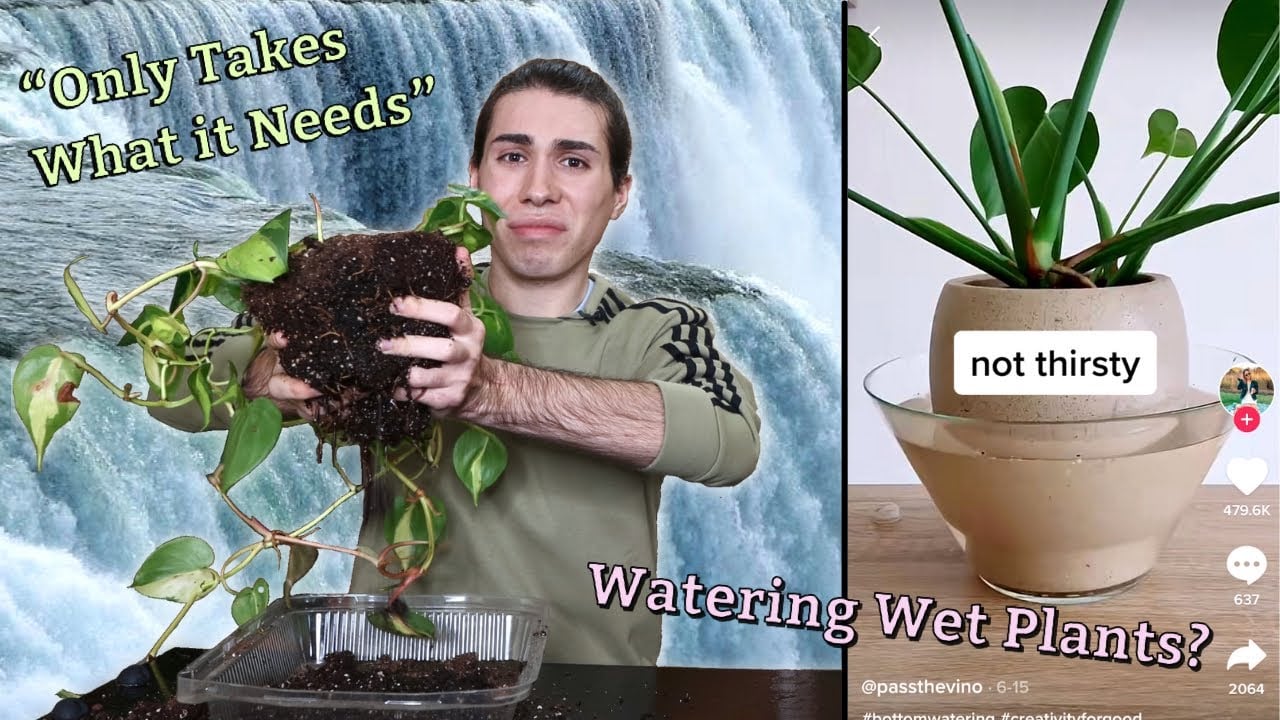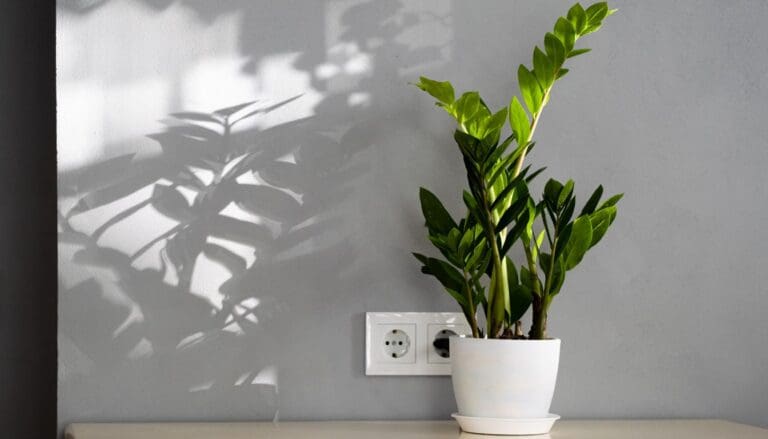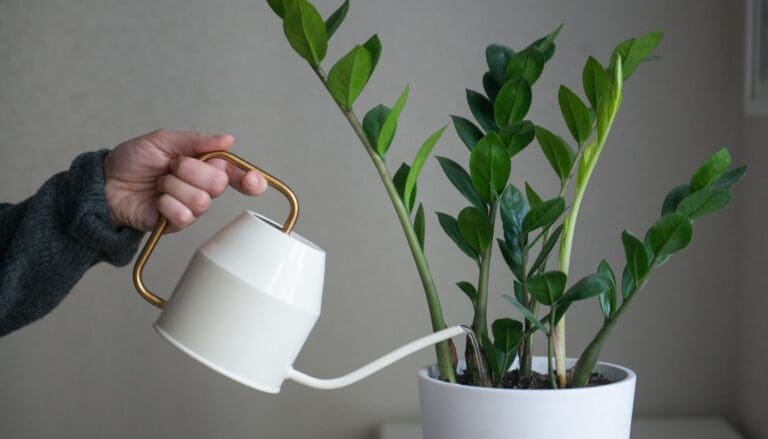Bottom Watering vs Top Watering Houseplants: Which Method Works Best?
Watering our beloved houseplants seems like a simple task, right? Just grab a watering can and pour away! But, have you ever wondered if you’re quenching your plants’ thirst the right way?
Turns out, there’s a little more to it than just making it rain on your green bffs. We’ve got two contenders in the ring: top watering and bottom watering.
I used to be a top-waterer, blissfully unaware that there was any other way. Top watering is straightforward – you pour water over the soil and let it sink in, giving the leaves a little shower in the process. It’s the go-to method for many plant parents, and let’s be honest, it kind of feels like you’re playing rain god for your potted pals 🌱🌧️.
But then I stumbled upon bottom watering; a method where you let your plants sip water from a saucer below, letting the roots and soil soak up moisture from the bottom up. It’s like a stealthy submarine mission for hydration! 🛳️
Now, I’m not here to pick sides—I love all my leafy friends equally! But it’s fascinating to see how these approaches differ, and I bet you’re curious too!
Are you team top watering, or do you pledge allegiance to the bottom watering brigade? Why don’t we dive into the perks and quirks of each method and find out the best way to keep our green companions thriving. And hey, share your watering wisdom in the comments! Do you have a tried-and-true technique, or are you experimenting like me? Let’s grow this conversation together! 🌿💦

Please note: Simplify Plants is reader-supported. As an Amazon Associate, I earn from qualifying purchases made by our readers with no extra cost added to you all! Some links in the post are affiliate links and I get a commission from purchases made through links in the post.
Understanding Bottom Watering
Hi plant lovers! If you’ve ever scratched your head wondering about the ins and outs of bottom watering, stick around. I’ll guide you through what it is, why it might just be a game-changer for your leafy friends, and the perfect times to employ this hydrating tactic. 🌱💧
Definition and Process
Bottom watering is like a spa day for your plants! It’s all about letting your plants drink up water at their own pace from the bottom up. Here’s how you do it:
- Fill a tray or sink with about an inch or two of water.
- Place your plant in its pot in the water.
- Let the plant soak up moisture from the bottom until the topsoil is damp.
- Remove the plant and let it drain. No more overwatered, sad plants!
Easy, right? Have you tried this method before? 😊
Advantages of Bottom Watering
Here are some perks that’ll have you and your plants jumping for joy:
- Consistent moisture: Every bit of soil gets a drink, leaving no dry spots!
- Healthier roots: They grow downwards searching for moisture, which encourages a robust root system.
- Reduces pests and diseases: Unlike top watering, which can leave your plant wet and vulnerable, bottom watering keeps the foliage dry and less attractive to those pesky critters.
- No more mess: Say goodbye to water spills from the top!
Taking notes? Your plants might just thank you for it!
When to Use Bottom Watering
So, when should you opt for this roots-first approach?
- When the soil is super dry: It’ll help rehydrate more evenly.
- For delicate seedlings: To avoid disrupting their growing medium.
- When you want to minimize salt build-up: Bottom watering helps prevent those white crusty lines on the pot.
Sound like something your green buddies would appreciate? Give it a shot and let me know how it goes! Ever experienced the magic of bottom watering? Share your stories below! 🌿👇
Exploring Top Watering

Before we dive in, let me share the basics of top watering: it’s accessible, straightforward, and might just be the go-to method for keeping your green buddies perky!
Definition and Technique
When I talk about top watering, I’m referring to the way most of us have probably been nurturing our leafy friends – pouring water onto the soil at the base of the plant.
It’s as simple as grabbing a watering can and giving your plant a drink from above, just like a gentle rain shower.
Benefits of Top Watering
The perks of this method? Top watering ensures that the entire root system gets some love, encouraging deeper root growth. Plus, it washes away those pesky excess minerals that accumulate over time – goodbye, mineral build-up! 🚿
When to Use Top Watering
So, when should you stick to the top-down approach? I find it’s best for plants with deep roots or for those dry periods when your plant pals are seriously parched. And if you’ve got a new seedling sprouting up, you’ll want to keep the soil surface moist.
Remember, no one knows your plant better than you! Have you tried both methods? Which do your plants seem to prefer? Drop a comment and let’s green up our thumbs together! 🌱💬
Comparing Bottom and Top Watering
When it comes to keeping my houseplants happy, I’ve discovered that how I water them makes a real difference. Do you go the traditional route and sprinkle from above, or are you one to let the roots sip at their leisure from below? Let’s dive in!
Efficiency and Water Usage
Bottom watering is like treating your plants to a spa day. I simply fill a tray with water and let my plants drink up from the bottom. This method encourages water to reach the entire root system, potentially leading to less frequent watering.
However, top watering is like a quick shower for plants, straightforward and speedy, but it might not quench the deeper roots.
Root Health and Growth
A big cheer for strong roots! 🎉 With bottom watering, I find that roots grow downward, seeking moisture, which can lead to sturdier plants.
Who doesn’t want that? On the flip side, top watering can sometimes cause roots to stay shallow; they just don’t need to work as hard.
Risk of Disease and Pests
When I water from the top, there’s always a chance I’ll get the leaves too wet, and we all know that can be an open invitation to fungal diseases and pests – party crashers that no plant parent wants.
Bottom watering keeps the foliage dry, reducing that risk significantly. Isn’t that a relief?
Do you prefer the quick sprinkle from above or the root-soaking goodness of bottom watering? Drop your thoughts and experiences below – let’s grow this conversation! 🌱
And don’t forget to hit share if you found this helpful or if you think it might aid a friend in their plant-care journey!
Practical Tips for Watering Houseplants

Let’s get our green friends thriving, shall we? Watering your plants is more than just a pour-and-go; it’s about understanding their unique thirst levels. 🚿
Determining Your Plant’s Water Needs
First up, I always check my plant’s soil before deciding to water. Different plants demand different moisture levels. So, how do you know when to water?
Here’s a simple trick: stick your finger about an inch into the soil. If it’s dry, it’s time to reach for that watering can! Some plants love to dry out between drinks, while others prefer a constant level of moisture.
- Cacti and succulents: Let the soil dry out completely.
- Ferns and tropicals: Keep consistently moist.
Frequency and Amount of Watering
Remember, consistency is key! I set a schedule based on the specific needs of my plants, which prevents both underwatering and the dreaded root rot. The amount of water you give should reach the roots without leaving them soaked:
- Small pots: A few ounces might be plenty.
- Large pots: Might need a quart or more.
It’s all about balance, folks. Overwhelmed? Don’t worry, you’ll get the hang of it!
Water Quality and Temperature
Did you know that plants can be picky drinkers? Water quality can affect your plants as much as it affects us. Tap water is fine for most, but if you notice brown tips on the leaves, try using filtered or rainwater.
Always go for room-temperature water; cold can shock the roots and hot water is a no-no – nobody wants a steamy root bath!
- Tap water: Let it sit overnight to reduce chlorine.
- Filtered water: Great for sensitive plants.
Don’t forget, folks – every plant is unique, just like us! Found a tip that works wonders for your leafy pals? Share it in the comments! 🌱💬 Let’s grow a community of happy, hydrated houseplants together!
Common Mistakes to Avoid

Navigating the waters of plant care can be tricky, but I’m here to steer you clear of common watering pitfalls that could dampen your green-thumbed enthusiasm. Let’s dive in, shall we? 😄
Overwatering and Underwatering
Overwatering is like that guest who overstays their welcome at a party—both can suffocate the vibe. Remember, not all plants guzzle water like a teenager after sports practice. Underwatering, on the other hand, is the equivalent of forgetting to feed your cat—neither the cat nor your plant will thank you for it. How do you steer clear of trouble?
- Check soil moisture before watering—about an inch deep should do the trick.
- Observe your plant’s leaves. Are they drooping like they’ve watched too many sad movies? It might be time for a drink.
Ignoring Environmental Factors
Sunlight and temperature can turn your watering routine into a real brainteaser. A plant basking in the sun like it’s on vacation in Hawaii is going to need more water than one chilling in the shade. And just like you wouldn’t wear a parka to the beach, don’t drown your plants in water when it’s cool and cloudy out.
- Adjust your watering to the seasons—plants drink more in summer and less in winter.
- Watch for heatwaves or cold snaps that can throw a curveball into your plant’s thirst levels.
Inadequate Drainage
Raise your hand if you’ve ever been personally victimized by a pot without drainage holes. Yep, I see those hands. Root rot is the nightmare that lurks at the bottom of such a pot, waiting to ruin your leafy friend’s day. Here’s what to do:
- Use pots with drainage holes—non-negotiable.
- For extra precaution, toss in some gravel or pebbles at the bottom to keep those roots dry and happy.
So, what watering mishaps have you turned around and conquered? Share your stories or questions below—I’d love to hear them! And hey, if this info quenched your thirst for knowledge, feel free to pass the pitcher to your fellow plant lovers. 🌱💧
Advanced Techniques and Considerations
Ever feel like you’re in an endless cycle of watering your leafy friends without quite hitting that sweet spot? Well, it’s time to gear up and fine-tune your watering game with some advanced techniques that’ll make your plants say, “Ahh, that’s the stuff!” 🌱💧
Using Wicking Systems

Have you ever heard of wicking systems? No, it’s not a magic trick, although your plants might think so!
Here’s the deal: a wick, which is usually made of a porous material like cotton, connects the plant’s soil to a water reservoir.
The system uses capillary action to draw up water as needed, which means less work for me and a constant happy hour for my plants. Who wouldn’t want that?
Self-Watering Pots
Now, let me tell you about the game changer: self-watering pots. It’s like hiring a babysitter for your plants!
These pots have built-in reservoirs that allow the plant to drink at its own pace.
I love that these nifty pots help prevent over and under-watering, and they are ideal when I’m away on a trip. Vacation for me and a staycation for my plants! 😎🌴
Seasonal Adjustments
Alright, ready for a pro tip? Just like I swap my wardrobe when seasons change, I tweak my watering strategy, too.
In the warmer months, my plants thirst more, so I up their intake. But come cooler times, I scale back to prevent soggy soil blues.
Remember, the length of daylight and indoor heating can also affect your plant’s thirst level – monitor and adjust accordingly!
FAQs
What’s the difference between top and bottom watering? 🤔
I’m glad you asked! Top watering means pouring water over the soil—yep, just like a gentle rain shower for your green buddies.
Bottom watering, on the other hand, is like throwing a little pool party for your pots, letting them sip up water from the bottom.
Does bottom watering take longer?
It can be a bit of a waiting game—sometimes just a few minutes, or it could stretch for a couple of hours. But hey, your plants deserve some ‘me’ time too, right? 🕒
What about these mineral salts I keep hearing about?
Okay, science time! Top watering can wash away excess salts from fertilizers, while bottom watering can bring them up to the surface.
So, if you’re using hard water, you might want to stick to the top. Keep your plants salt-free like a diet-conscious foodie! 🚫🧂
Can I bottom water foliage plants?
Watch out! Water-sensitive leaves might not enjoy the top-down approach, so in that case, your bottom watering skills are the hero.
Just make sure not to leave them soaking like forgotten tea bags. 🍃
Is bottom watering a one-size-fits-all?
Not exactly. Succulents and cacti are the desert adventurers of the plant world—they don’t appreciate the underwater scene so much. Remember, knowing your plant’s vibe is key.
Conclusion
If you’ve been following our watering showdown, you’re now a well-versed hydration guru.
Whether you’re Team Top Watering or Team Bottom Watering, remember that the end goal is a happy, healthy plant with a big smile (if they could smile, that is 😄).
For Team Top, it’s all about that gentle shower. Give your green babies the rainfall treatment, and make sure you’re not overdoing it to avoid a flood situation.
As for Team Bottom, patience is your virtue. Let your plants sip slowly from their personal mini-reservoirs.
Whichever you choose, just make sure the soil feels the love all the way through!
Here’s a pro tip: switch it up sometimes! Plants, like us, enjoy a bit of variety.
Why not try a little of both methods and see what vibes with your verdant friends?
So, what’s your take? Are you a top devotee or a bottom buff? Drop me a line in the comments with your watering wins, and let’s grow this community garden of wisdom together!
Oh and if you think this is helpful, hit that share button – let’s spread the green thumb love! 🤗🌱
Remember, there’s no one-size-fits-all in the plant kingdom. Keep exploring, and soon you’ll find the technique that makes both you and your leafy friends thrive.
Recommended Garden Supplies
| Product Image | Our Recommended Gardening Supplies | Check Offers! |
|---|---|---|
Top Top
Top
Top
Top
Top
Top
Top
Top | rePotme Houseplant and Tropical Classic Potting Soil Mix | Check Offer On Amazon |
 Top
Top
Top
Top
Top
Top
Top
Top | Espoma Organic Indoor Plant Food | Check Offer On Amazon |
 Top
Top
Top
Top
Top
Top
Top
Top | GooingTop LED Grow Light 6000K Full Spectrum Clip Plant Growing Lamp | Check Offer On Amazon |
 Top
Top
Top
Top
Top
Top
Top
Top | Soil Moisture Meter | Check Offer On Amazon |
 Top
Top
Top
Top
Top
Top
Top
Top | Govee Hygrometer Thermometer, Bluetooth Enabled! | Check Offer On Amazon |
 Top
Top | LEVOIT Humidifiers for Large Room(Best For Plants) | Check Offer On Amazon |
 Top
Top
Top
Top
Top
Top
Top
Top | Upgraded DIY Automatic Drip Irrigation Kit, 15 Potted Houseplants Support | Check Offer On Amazon |
 Top
Top
Top
Top
Top
Top
Top
Top | Stainless Steel Heavy Duty Gardening Tool Set | Check Offer On Amazon |
 Top
Top
Top
Top
Top
Top
Top
Top | Bonide Insecticidal Soap | Check Offer On Amazon |
 Top
Top
Top
Top
Top
Top
Top
Top | Bonide 32 oz Spray Neem Oil for Organic Gardening | Check Offer On Amazon |
 Top
Top
Top
Top
Top
Top
Top
Top | Garden Safe Fungicide | Check Offer On Amazon |







